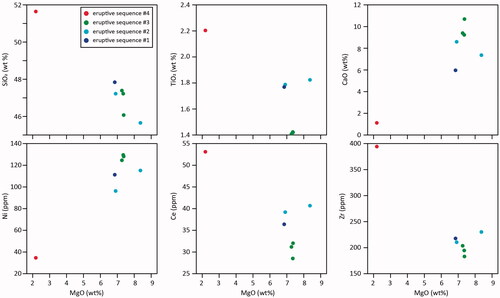Abstract
We report composition and age data from a restricted <370 km2, volcano-sedimentary basin beneath Mesozoic cover to the northwest of the Flinders Ranges, South Australia. This volcano-sedimentary basin comprises two components: a sedimentary sequence that includes shales, siltstones and sandstones, and a basalt–sedimentary member. Together, these components are defined as the Ooloo Hill Formation. Whole-rock K–Ar geochronology for five basalt samples yields a preferred mean K–Ar age of 392 ± 8 Ma. Two samples of detrital zircons from the sedimentary rock yield SHRIMP U–Pb maximum depositional ages of ca 527 and 510 Ma. These ages are significant, as they rule out a Neoproterozoic age for the sedimentary basin and demonstrate that this basin is not part of the Adelaide Superbasin. Lower eruptive sequences are calc-alkaline and mafic in composition (SiO2 = 46.1–47.8 wt%, Na2O + K2O = 3.7–6.1 wt%, MgO = 6.85–8.37 wt%, Mg# = 57–65 and εNd(390 Ma) = 3.4–4.0) and may represent two small-scale melting events from compositionally distinct mantle reservoirs. The uppermost eruptive sequence is tholeiitic andesite (SiO2 = 51.6 wt%, Na2O + K2O = 8.1 wt%, MgO = 2.2 wt%, Mg# = 27 and εNd(390 Ma) = 3.0) and displays geochemical affinity to the first two eruptive sequences, possibly representing a differentiated magma from a similar source region. Incompatible trace-element ratios and isotopic compositions suggest the source was a heterogeneous oceanic island basalt-like parent magma derived from partial melting of the asthenospheric mantle. We envisage decompressional melting was linked to large-scale tectonic processes inboard of the Tasman Orogen, with magma ascent facilitated by crustal faulting.
First record of a mid-Devonian intracontinental volcano-sedimentary basin in South Australia.
Basalts have an oceanic island basalt-like mantle source that represents at least two small-scale melting events from compositionally distinct mantle reservoirs.
A localised mid-Devonian backarc basin or transpressional/transtensional basin linked to intracontinental faulting formed inboard of the Tasman Orogen.
KEY POINTS
Introduction
Throughout the Paleozoic, plate-margin processes at the east of the Australian continent resulted in prolonged and complex intracontinental tectonics across eastern and central Australia. Forces from the distant plate margin(s) were transmitted across the continent and expressed as reactivation of ancient structures or the formation of new structures that generated uplift creating topography, or down-warping creating new basins (e.g. Glorie et al., Citation2017; Hand & Buick, Citation2001; McLaren et al., Citation2002; Raimondo et al., Citation2014). In some locations, these tectonic forces were also linked to largely crustally derived magmatism, for example in the high-heat producing region of the northern Flinders Ranges at Mt Painter (Elburg et al., Citation2003; McLaren et al., Citation2002). In general, however, regional stress fields can also influence the way in which mantle melts form, accumulate and migrate as a result of flexure of the lithosphere and associated asthenospheric coupling (Valentine & Hirano, Citation2010). Mantle melts may be squeezed upward by tectonic forces associated with plate flexure if the source is susceptible to partial melting, forming low eruption-flux volcanoes in intraplate volcanic provinces (Hirano, Citation2011). Indeed, in such settings, which involve steep lithospheric pathways, asthenospheric melts may ascend to the surface via fractures with little interaction with the lithospheric mantle. Therefore, in the complex tectonic environment of intracontinental Paleozoic Australia, we should expect to find regions in which mantle melting did occur, and yet there are few examples of mafic magmatism that post-date the Cambro-Ordovician Delamerian Orogeny in South Australia.
One exception to this is a series of basaltic rocks associated with localised sedimentation that formed in a restricted, intracontinental basin located to the north of the Flinders Ranges, South Australia, defined as the Ooloo Hill Formation (). The Ooloo Hill Formation represents a unique composite of siliciclastic and volcaniclastic debris along with shallow submarine basalt flows. In this paper, we present a geochemical and geochronological investigation into these rock packages. The results suggest this area, now entirely buried beneath Mesozoic and Cenozoic successions, contains the remnants of a small volcano-sedimentary basin active in the Devonian. Ooloo Hill Formation volcanic rocks may represent a type of fracture-controlled volcanism formed on continental lithosphere, characterised by low-volume melt production originating in the asthenosphere without a hotspot or mantle plume. We suggest a connection between far-field tectonic forcing at the paleo-Pacific margin coupled with intracontinental deformation that occurred in this region to form this unique volcano-sedimentary basin.
Figure 1. Location of the Ooloo Hill Formation with respect to the Tasman Orogen, Thomson Orogen and other orogenic and cratonic regions of southeast Australia. Also shown are outlines of the extent of the Warbuton Basin and Eromanga Basin, outlined so as to not obscure the underlying Proterozoic–Paleozoic regions. Note that the change in colour of Delamerian and Thomson orogens at their western margin shows regions of overlap with underlying Archean–Proterozoic basement. Insert shows location with respect to Australia. All province regions are from Geoscience Australia Australian Geological Provinces 2018.01 edition (Raymond, Citation2018). Base layer is Australian Total Magnetic Intensity grid from Geoscience Australia in black–white stretch (Minty & Poudjom Djomani, Citation2019).

Geological setting
The oldest crystalline basement rocks to crop out in the northern Flinders Ranges are those of the Mount Painter and Mount Babbage inliers, part of the northwestern Curnamona Province. These basement rocks include Mesoproterozoic metasedimentary rocks of the Radium Creek Group (1595–1580 Ma; Armit et al., Citation2014), and felsic igneous rocks of the Petermorra Volcanics (1560–1550 Ma) and Moolawatana Suite (1560–1550 Ma; Sheard et al., Citation1992). Deformational and alteration overprints are recorded in the Mount Babbage and Mount Painter inliers (Sheard, Citation2009; Sheard & Callen, Citation2000; White et al., Citation2012). Radium Creek Group rocks were metamorphosed and deformed in the early Mesoproterozoic and Paleozoic (Armit et al., Citation2012; Elburg et al., Citation2003; McLaren et al., Citation2002) and exhibit five strong deformation fabrics deriving from late Mesoproterozoic to early Neoproterozoic dynamic–thermal metamorphism, in addition to lower-intensity fabrics from the Cambro-Ordovician Delamerian Orogeny (Sheard, Citation2009). Radium Creek Group rocks are intruded by minor pegmatite dykes and plutons interpreted to be Cambro-Ordovician in age (Elburg et al., Citation2003). Paleozoic magmatism (460–440 Ma) is recorded in the central part of the inlier (Elburg et al., Citation2003; McLaren et al., Citation2006).
Extensive sedimentary rocks overlie the basement inliers (). Neoproterozoic sedimentary rocks of the Adelaide Superbasin are themselves disconformably overlain by Cambrian sedimentary rocks within the Arrowie Basin and Cambro-Ordovician sedimentary rocks of the Warburton Basin. Sequences in the Adelaide Superbasin were deposited in a passive margin setting and host rift-related upper Neoproterozoic to Lower Ordovician mafic igneous suites and middle Cambrian–Lower Ordovician (514–475 Ma) syn to post-tectonic granites and felsic volcanic rocks (Foden et al., Citation2006; Lloyd et al., Citation2020; Preiss, Citation1987). During the early Cambrian, Neoproterozoic sedimentary rocks of the Adelaide Superbasin experienced deformation and metamorphism associated with the Delamerian Orogeny (ca 514–490 Ma; Foden et al., Citation2006; Preiss, Citation1995). Post-Delamerian Orogen thermal overprints recorded in monazite and epithermal systems-deposits associated with Mounts Gee and Painter provide evidence for a ca 360 Ma hydrothermal–epithermal event in the southern Mount Painter Inlier (Hore et al., Citation2020).
Mesozoic sedimentary rocks of the Eromanga Basin unconformably overlie the northern Arrowie Basin. These Jurassic to Cretaceous fluvial and marine units are themselves unconformably overlain by Cenozoic terrestrial sediments of the Lake Eyre Basin (Alley, Citation1998; Sheard, Citation2012; White et al., Citation2012).
Ooloo Hill Formation
Rocks of the Ooloo Hill Formation were originally detected by aeromagnetics, where they form a zone <370 km2 of irregular magnetic texture with a distinct elongated anomalous high some 80 km northeast of Lyndhurst and the adjacent Strzelecki Track (). The lateral extent is defined by a northwest–southeast-oriented aeromagnetic feature approximately 17 × 6 km in size ().
Figure 2. Surface geology and total magnetic intensity (TMI) maps of the northern Flinders area, showing the location of drillholes that intersect the Ooloo Hill Formation. (a) Simplified surface geology of the northern Flinders area. (b) Aeromagnetic TMI imagery showing the location of the magnetic anomaly that forms the Ooloo Hill Formation. (c) Location of the drillholes that intersect the Ooloo Hill Formation. Drillhole RD/DD94WB2 penetrates basalt lavas below ∼280 m Mesozoic to Cenozoic cover. Drillholes RD/DD94WB3 and RD/DD94WB4 penetrate siltstones, shales and minor sandstones, below ∼300 m Mesozoic to Cenozoic cover.

The formation has been intercepted in three cored drillholes: RD/DD94WB2, RD/DD94WB3 and RD/DD94WB4 (Barlow & Waterfield, Citation1995; ). The Ooloo Hill Formation is presumed to rest unconformably upon Neoproterozoic metasedimentary rocks, neither of which are exposed at surface in the region. Unconformably overlying the Ooloo Hill Formation are ∼280 to ∼300 m of Mesozoic Eromanga Basin and Cenozoic Lake Eyre Basin sediment (; Sheard, Citation2012; White et al., Citation2012).
Figure 3. Graphic log and depositional regime to cored drillhole RD/DD94WB2 showing sample depths and analysis type for each sample collected. The basalt lavas and sedimentary succession occur below 279.5 m of Cretaceous to Cenozoic cover.
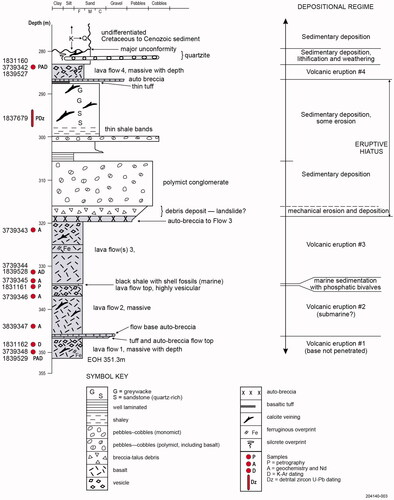
The Ooloo Hill Formation (Sheard, Citation2012; White et al., Citation2012) contains two components; a sedimentary sequence that constitutes the bulk of the formation, and more localised basaltic volcanic rocks that are associated with a volumetrically lesser clastic to epiclastic sediment member (). The main sedimentary sequence is found in drillholes RD/DD94WB3 and RD/DD94WB4, whereas drillhole RD/DD94WB2 contains the basaltic and a volumetrically minor sedimentary member (Barlow & Waterfield, Citation1995; ). Correlation of clastic to epiclastic sedimentary rocks in the basaltic volcanic–sedimentary member with those of the main sedimentary sequence is tenuous because none of the drill cores expose a recognisable basal contact. Coarse-grained clastics of the basaltic volcanic–sedimentary member do not resemble any sedimentary rock within the bulk of the sedimentary sequence; however, there is some resemblance of dark shales between the two sequences. Basaltic units from the basaltic volcanic–sedimentary member from drillhole RD/DD94WB2 are the focus of this study. To provide a constraint on the timing of formation of the basalts, we have analysed basaltic material by whole-rock K–Ar methods and applied a whole-rock geochemical and Sm–Nd isotopic analysis to understand their petrogenesis. Accompanying this, we have attempted detrital zircon dating via a sensitive high-resolution ion microprobe (SHRIMP) on the sedimentary rocks from drillholes RD/DD94WB2 and RD/DD94WB3 to provide further constraints on the provenance of these rocks. provides a summary of samples collected from drillhole RD/DD94WB2, as shown on .
Table 1. Summary of samples, depths and analysis types from drillhole RD/DD94WB2 (GDA2020, 307424 mE, 6701243 mN, Zone 54).
Sedimentary sequence
The volumetrically larger sedimentary sequence in drillholes RD/DD94WB3 and RD/DD94WB4 consists of laminated and massive greyish to tan hued shales and thick tan to dark brownish grey siltstone that are likewise either well laminated or massive (). The shales and siltstones contain slump structures, slump breccias, cross-bedding, ripple marks, small scour-and-fill structures and fine lamellae. Sparse fossil fragments including phosphatic and calcareous shell fragments (<0.5 mm in length) occur in and adjacent to sandy lenses. Shale is interstitial to larger, curved, mostly phosphatic shell fragments (possibly bivalves) to <8 mm long (). Pale-hued, fine- to medium-grained sandstone beds () are intercalated within the shales and siltstones. Sandstone beds are quartz grain dominated, comprising abundant subrounded to angular quartz grains with interstitial granular carbonate (30–35 vol%), minor microcline, shredded muscovite flakes, leucoxene-rich grains and rare opaque oxide, apatite, biotite, zircon and tourmaline grains, and weathered lithic and feldspar grains ().
Figure 4. Rock types of the Ooloo Hill Formation. (a) Laminated marine shale and siltstone with soft sediment slumping in drillhole RD/DD94WB3, 352–355 m. (b) Sandstone, drillhole RD/DD94WB2, ∼296 m. (c) Inter-volcanic–sedimentary rock. The conglomerate consists of rounded to subangular dark grey basalt clasts with an interstitial matrix of lithic-rich sand and silt in drillhole RD/DD94WB2, 297.5–302 m. (d) Bedded sedimentary rock with intercalated sandy and silty shale layers, including calcareous and phosphatic shell fragments from RD/DD94WB2, ∼335 m. (e) Autobreccia flow top or bottom RD/DD94WB2, ∼285 m. (f) Fine-grained basalt from drillhole RD/DD94WB2, ∼348 m (flow #2). (g) Fine-grained basalt from drillhole RD/DD94WB2, ∼331–332 m (flow #3). (h) Vesicular basalt, fine-grained basalt with amygdaloidal flow top in drillhole RD/DD94WB2, ∼336 m (flow #4).
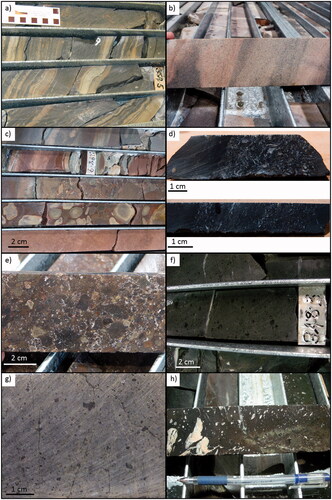
Figure 5. Photomicrographs of some Ooloo Hill Formation components. (a) Inter-lava flow. Bedded shale with intercalated fine-grained sand, silt, and mud layers, including accumulation of calcareous and phosphatic shell fragments. In the middle left of field are mid-sized fragments of an impunctate calcareous brachiopod shell displaying primary and secondary layers. The brownish (presumably phosphatic) shell fragment next to the brachiopod fragment could be an external plate of an armoured fish (G. Brock pers. comm., 2021), sample 1831161, ∼335 m RD/DD94WB2. (b) Inter-lava flow. Isolated phosphatic or calcareous bivalve shells (2–3 mm long, lower left corner). Thin shelled, low convexity shell fragments of indeterminate brachiopods (possibly strophomenids (G. Brock pers. comm., 2021)); sample 1831161, ∼335 m RD/DD94WB2. (c) Quartz-rich, fine-grained sandstone with extensive interstitial carbonate, minor feldspars, muscovite, tourmaline, leucoxene and opaque oxides, sample 1837680, ∼358 m RD/DD94WB3. (d) Inter-lava flow sedimentary rock. Porous quartz-rich fine- to medium-grained sandstone with minor interstitial chlorite, carbonate, and clay. Sample 1837679, ∼295 m RD/DD94WB3. (e) Lowest flow basalt composed of albite–chlorite–carbonate-altered olivine basalt with clinopyroxene in a fine-grained groundmass of flow-orientated plagioclase laths. Former olivine phenocrysts up to 2.5 mm have been altered to chlorite ± carbonate, sample 1722520, 349.14 m, RD/DD94WB2 (flow #1). (f) Flow-orientated plagioclase laths in lower flow basalt, sample 1722518, 337.67 m, RD/DD94WB2 (flow #2). (g) Middle lower lava flow basalt composed of altered olivine basalt with clinopyroxene (possibly titanaugite) in a fine-grained groundmass. Large (up to 1 mm) and flow-oriented plagioclase laths are present, sample 1722516, 331.7 m RD/DD94WB2 (flow #3). (h) Top lava flow composed of weakly plagioclase porphyritic amygdaloidal basalt with quartz–biotite–hematite–chlorite alteration. Amygdales are filled with carbonate ± epidote ± chlorite. No visible olivine phenocrysts were observed in this sample. Sample 1722514, 283.25 m, RD/DD94WB2 (flow #4).
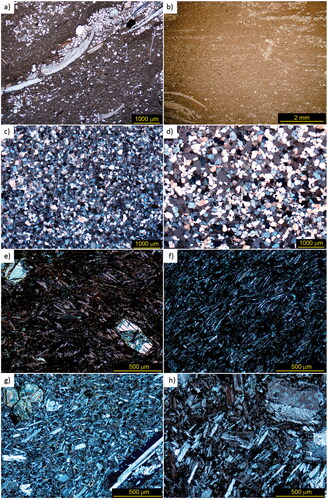
Basaltic volcanic and sedimentary member
Basaltic volcanic rocks are dark grey to black and dark greenish grey vesicular to massive lavas with autobreccia basal zones and some remnant autobreccia tops separated by clastic sedimentary rocks (). Basalt lavas are fine-grained with sparse phenocrysts and abundant vesicles near flow tops and flow-oriented albitised plagioclase laths. Alteration is present including chlorite and epidote replacement of glass, sericite alteration of plagioclase and alteration of primary titanite to leucoxene and altered olivine phenocrysts (). Vesicles are typically infilled by secondary calcite but have thin relict rims (originally glassy) composed of secondary chlorite and epidote or clay replacements. Interleaved with these rocks are polymict conglomerates containing well-rounded to subangular lithic clasts (mostly weathered basalt, ). In addition, there are thin laminar dark-hued fine-grained sedimentary intervals and tuff beds interbedded with some of the basalts. Two sub-centimetre-thick bands of phosphatic to calcareous shells and shell hash of mostly bivalve molluscs () also occur within one flow.
Four lava flows are recognised ( and ). The lowest lava has chlorite ± carbonate altered olivine phenocrysts up to 2.5 mm across. This lava also displays flow-oriented albitised plagioclase laths (), altered primary titanite as leucoxene and Ti-rich pyroxene relicts (). Middle lower lava flow basalt is composed of altered olivine with clinopyroxene (possibly titanaugite) in a fine-grained groundmass. Large, fresh plagioclase (up to 1 mm) and flow-oriented plagioclase laths are present. The upper lava is separated from the lower three flows by ∼30 m of clastic sedimentary rocks that includes several disconformities to unconformities. This unit contains sparse albitised plagioclase phenocrysts to 2 mm-long and sparse amygdales filled with carbonate ± fine-grained epidote, locally rimmed by chlorite and lacks visible olivine. The groundmass is composed of albitised plagioclase with interstitial chlorite, hematite and possible leucoxene ().
Analytical methods
K–Ar geochronology
Five basaltic samples were analysed for whole-rock K–Ar geochronology. The K–Ar standard methods used in this study are described in Zwingmann and Mancktelow (Citation2004) and are summarised below with the complete analytical method described in the Supplemental data (Appendix 1). K content was determined by atomic absorption. The pooled error of duplicate K determinations on several samples and standards is better than 2.0%. Ar isotopic determinations were performed using a procedure similar to that described by Bonhomme (Citation1975). About 25 mg of sample material was required for Ar analyses. During this study, international standards HD-B1 and LP6 were measured several times (). The error for Ar analyses is below 1.00%. The K–Ar ages were calculated using 40K abundance and decay constants recommended by Steiger and Jäger (Citation1977).
Table 2. K–Ar geochronology results for basalts from the Ooloo Hill Formation.
SHRIMP U–Pb geochronology
Data for two sedimentary rocks were collected over two analytical sessions. The complete analytical method is described in the Supplemental data (Appendix 1). 206Pb/238U dates are reported for analyses <1100 Ma, and 207Pb/206Pb for analyses >1100 Ma. All pooled ages are quoted with uncertainties at the 95% confidence level. U–Pb zircon data are presented in the Supplemental data (Appendix 3).
Geochemistry and Sm–Nd isotopic analysis
Major- and trace-element analyses were performed at Macquarie University. Major elements were analysed by X-ray fluorescence spectrometry. Trace and rare earth elements were determined by laser ablation-inductively coupled plasma-mass spectrometry (LA-ICP-MS). A detailed analytical method for whole-rock geochemistry is described in the Supplemental data (Appendix 1). BCR-2 was used as the calibration standard with BIR-1 and BHVO-2 analysed as unknowns at varying dilutions. Accuracy on all major elements for BCR-2 was <1% except for Na2O, and P2O5, K2O and MnO, which were <2%, and <3%, respectively, and <1% for BHVO-2 except for Al2O3 (<2%), MnO (<4%) and P2O5 (<19%). Accuracy for BIR-1 (n = 5) is <15% for all trace elements except Cu, Rb, Cd, Ba and Th (≤20%), Ta, Cs, Li (<30%), Cr (≤35%) and Mo (≤70%). Accuracy for BHVO-2 (n = 4) is <15% for all trace elements except Yb, Hf, Ta and Cu (<16%), Cr and Li (≤24%) and Be, Cd and W (<48%). The Supplemental data (Appendix 2) present all BCR-2, BIR-2 and BHVO-2 data.
Sm–Nd isotope analyses were performed at the University of Adelaide following the method of Wade et al. (Citation2006). Nd analyses were conducted using a Finnigan MAT262 thermal ionisation mass spectrometer, in static and quadruple-cup dynamic measurement modes, normalised to 146Nd/144Nd = 0.721903 and Nd concentrations corrected for 200 pg blank. Sm analyses were carried out on a Finnigan MAT262 thermal ionisation mass spectrometer, in static mode, and Sm concentrations were corrected for a 150 pg blank. The measured 143Nd/144Nd ratio for the BHVO-2 standard is 0.512872 ± 0.000010 (n = 1), comparable with the GeoRem preferred value (0.512979 ± 0.000014; http://georem.mpch-mainz.gwdg.de/start.asp?dataversion=current). Calculated concentrations for Nd and Sm in BHVO-2 are 24.2 ppm and 5.9 ppm, respectively, and are within uncertainty of the GeoRem preferred values of 24.27 ± 0.25 ppm and 6.023 ± 0.057 ppm, respectively.
Results
Whole-rock K–Ar geochronology of the basaltic member
Whole-rock K–Ar geochronology was obtained for five basaltic samples from depth intervals representative of the four identified eruption sequences (). Three samples from the lower lava flows yield K–Ar ages of 400 ± 8 Ma (sample 1831162), 393 ± 8 Ma (sample 1839528) and 388 ± 8 Ma (sample 1839529; ). Ages obtained for the upper lava flow are 367 ± 9 Ma (sample 1831160) and 388 ± 8 Ma (sample 1839527; ). The mean age for all five analyses is 388 ± 8 Ma, with MSWD = 2.0 and a probability of 0.087. Omitting the uppermost sample (1831160), the mean age is 392 ± 8 Ma, with MSWD = 0.54 and a probability of 0.66. The K–Ar ages are consistent with a mid-Devonian age for the basaltic volcanism.
U–Pb detrital zircon geochronology of the sedimentary sequence
Two samples of syn-volcanic–sedimentary rocks from the Ooloo Hill Formation were dated. All grains are rounded and abraded with pitted surfaces indicating significant sedimentary transportation (). Both samples have a similar spectrum of zircon ages, and the combined dataset of 114 analyses gives a good indication of the provenance of the unit (Vermeesch, Citation2004). About half the grains are derived from Neoproterozoic sources, with ages ranging into the Paleoproterozoic and Archean. Both samples contain only a few Phanerozoic grains, with Cambrian grains of ca 527 Ma and ca 510 Ma being the youngest, providing a maximum age of deposition for the sedimentary succession ().
Figure 6. Representative zircon from Ooloo Hill Formation sedimentary rocks representing (a) 1837679; and (b) 1837680 in transmitted light (left) and CL (right). The grains are rounded with pitted surfaces from sedimentary abrasion. White scale bars represent 100 mm.
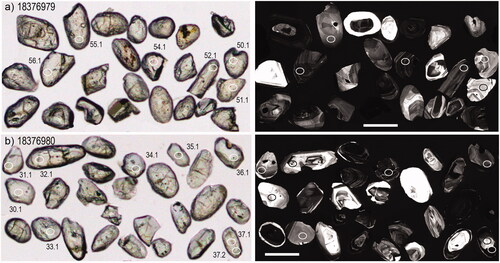
Figure 7. Probability density distributions (PDDs) of zircon ages for the Ooloo Hill Formation sedimentary rocks: (a) 1837679 from drillhole RD/DD94WB2, and (b) 1837680 from drillhole RD/DD94WB3. Peak ages listed on the graphs are calculated using AgeDisplay (Sircombe, Citation2004). The grey-shaded areas represent rejected analyses (see Supplemental data, Appendix 3), which are not included in the peak age calculations.
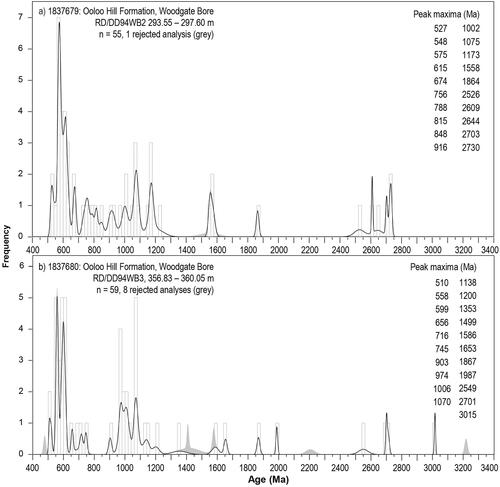
Sample 1837679 (RD/DD94WB2 293.55–297.60 m) is a quartz-rich sandstone from a ∼30 m interval of sandstone, arkose, greywacke and conglomerate within the succession of basaltic lava flows. Fifty-five zircons were analysed from 1837679. Archean and Paleoproterozoic grains (13%) range between ca 2735 and 2525 Ma with one younger grain (ca 1865 Ma). About a third of the grains are Mesoproterozoic, and over half are Neoproterozoic (53%), with dominant age peaks at 575 ± 5 Ma (MSWD = 0.62, probability of fit = 0.76, n = 9) and 615 ± 6 Ma (MSWD = 1.16, probability = 0.33, n = 7), and others at ca 1560, 1175 and 1075 Ma (). Two zircons are Phanerozoic in age, forming a peak at ca 527 Ma, providing the maximum age of deposition for the sample.
Sample 1837680 (RD/DD94WB3, 356.83–360.05 m) is from a succession of massive to well-laminated siltstones and shales with intercalated fine- to medium-grained sandstone beds. The sample is predominantly quartz-rich sandstone with lesser shale and siltstone thin bands, slumps and lamellae. Fifty-eight zircons were analysed from R18376780. Archean and Paleoproterozoic grains (15%) have scattered ages between ca 3200 and 1650 Ma. Mesoproterozoic and Neoproterozoic grains account for 70% of the population, with two dominant age peaks at 559 ± 5 Ma (MSWD = 0.42, probability of fit = 0.89, n = 8) and 602 ± 5 Ma (MSWD = 0.83, probability of fit = 0.56, n = 8), and others at ca 1070 and 975 Ma (). Three zircons are Phanerozoic in age. The youngest zircon (ca 477 Ma) contains high common Pb (5%), and the age is considered unreliable. Two slightly older Cambrian grains provide a more reliable maximum age of deposition of ca 510 Ma.
Whole-rock geochemistry and Sm–Nd isotopes
Mafic volcanic rocks from the Ooloo Hill Formation are basaltic but include trachy-basalt and basaltic trachy-andesite to trachy-andesite on the total alkali silica (TAS) plot (). Samples from the lower flows (eruptive sequences #1, #2 and #3) are lower in total alkalis, which correspond to basaltic compositions, whereas the upper flow (eruptive sequence #4) is basaltic trachy-andesitic to trachy-andesite in composition (). The alkali–FeO(tot)–MgO (AFM) diagram also differentiates the lower basaltic from the upper andesite samples, where the former are calc-alkaline and the latter tholeiitic in composition (). SiO2, MgO and Mg# [calculated as molar Mg# = (Mg / [Mg + Fe] × 100)] differ between the lower basalt flows and upper andesite flow. Lower eruptive basaltic sequences have SiO2 = 45.66–47.84 wt%, MgO = 6.85–8.37 wt% and Mg# = 57–65, whereas the upper eruptive andesitic sequence has higher SiO2 (51.64 wt%), lower MgO (2.19 wt%) and lower Mg# (27; ). Other significant differences in major-element compositions between the lower basalts and upper andesite include CaO and TiO2 () and Al2O3, Na2O and P2O5 (not shown; ). Lower basalt flows are high in Cr (168–233 ppm) and Ni (96–130 ppm) compared with the upper andesite flow (Cr = 76 ppm and Ni = 35 ppm). High-field-strength elements such as Zr, Th, Nb and Y are lower in abundance in the lower basalts than in the upper andesite (; ).
Figure 8. Classification diagrams for the Ooloo Hill Formation basalts. (a) Total alkali silica (TAS) diagram after Middlemost (Citation1994) showing the compositional range from basalt to trachy-andesite between eruptive sequences in the Ooloo Hill Formation. (b) Alkali (Na2O + K2O)–FeO(tot)–MgO (AFM) diagram after (Irvine & Baragar, Citation1971) showing the calc-alkaline affinity of the lower eruptive sequences (#1–3) compared with the tholeiitic composition of eruptive sequence #4.
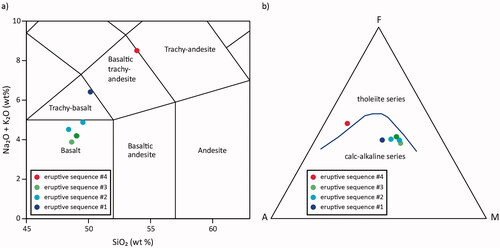
Table 3. Whole-rock geochemical data for mafic volcanic rocks from the Ooloo Hill Formation from drill hole RD/DD94WB 2 (GDA2020, 307424 mE, 6701243 mN, Zone 54).
Primitive mantle-normalised trace-element patterns for Ooloo Hill Formation basalt and andesite rocks are presented on . Large variations in large-ion lithophile element (LILE) abundance as observed in elements such as Rb, Ba and K are attributed to elevated abundances in eruptive sequence #1 basalt and lower Ba and K in eruptive sequence #3 basalt relative to the other basalt sequences. Apart from these noted differences in LILE, trace-element patterns in the lower basalts are similar and characterised by positive U, K, Hf and Zr anomalies, negative Nb–Ta and Ti anomalies, and small negative P anomalies (). Eruptive sequences #1 and #2 have similar trace-element abundances (excepting Ba and K) and near identical trace-element patterns (). Eruptive sequence #3 is distinguished from the other lower basalt sequences by its lower abundance of trace elements, in particular high-field-strength and rare earth elements, and its trace-element abundances more closely resemble enriched mid-ocean ridge basalt (EMORB) abundances (). The uppermost andesite (eruptive sequence #4) is distinguished from the lower basalts by its negative K and Sr anomaly, and elevated Zr and Hf abundances ().
Figure 10. Primitive mantle-normalised trace-element and chondrite-normalised rare earth element plots for the Ooloo Hill Formation basalts. Primitive mantle and chondrite normalising values from (Sun & McDonough, Citation1989). OIB, Ocean Island Basalt (Sun & McDonough, Citation1989); CIB, Continental Intraplate Basalt, Ethiopian Rift (GEOROC database); EMORB, enriched mid-ocean ridge basalt (Klein, Citation2004); NMORB, normal mid-ocean ridge basalt (Hart et al., Citation1999).

Chondrite-normalised rare earth element (REE) patterns show slightly sloping REE patterns in the lower basalts and upper andesite, governed by a small enrichment in La relative to Yb [(La/Yb)N = 2.6–3.5]. Eu/Eu* in the lower basalts = 0.94–1.1 (), which corresponds to a positive Eu anomaly in eruptive sequence #1 and subtle negative Eu anomalies in eruptive sequences #2 and #3 (). Whereas REE abundances in the lower basaltic flows (in particular eruptive sequences #1 and #2) are more enriched than EMORB (total REE abundance in the lower basalt flows is 87–118 ppm), the REE patterns are similar (). The REE pattern of the upper andesite is distinguishable from the lower basalts by higher abundances of REE (total REE = 150 ppm) and a more pronounced negative Eu anomaly (Eu/Eu* = 0.84).
Four basalts, each representing an eruptive sequence, were analysed for whole-rock Sm–Nd isotope compositions and are reported in . An extrusion age of 390 Ma, based on the K–Ar geochronology, is used for Nd calculations. εNd(390 Ma) values range from 3.4 to 4.0 in the lower basalts, and the upper andesite has an εNd(390 Ma) value of 3.0 (). TDM ages for all samples range between 1030 and 1000 Ma ().
Table 4. Sm–Nd data for basalts and andesite from Ooloo Hill Formation.
Discussion
Depositional setting
The sedimentary sequence for this formation was deposited in a marine, near- or offshore and slope environment in water of at least a moderate depth (not exceeding 300 m) as indicated by the abundant small-scale slumps, scours and ripples preserved in the laminated shales and low abundance of ash. During deposition, at least two episodes of basaltic volcanic activity took place, involving lava outpourings and minor ash emission. The lower multiphase episode (eruptive sequences #1 to #3) is separated from the last (eruptive sequence #4) by sufficient time for weathering and episodic erosion to occur with the intervening 30 m stratigraphic interval infilled by fine to coarse-grained non-volcanic detritus and epiclastic conglomerates. Whereas the sedimentary rocks are essentially fossil-absent, there are two millimetre- to centimetre-thick bands containing phosphatic to calcareous shells and shell hash in a thin black shale bed separating two basalt flows (at 334.4 m; ). These shells demonstrate that depositional conditions for that portion of the succession were marine, and possibly in shallow to near-medium-depth water.
Geochronological interpretation: timing of magmatism and sedimentary provenance
Whole-rock K–Ar dating methods indicate the mean age for all five lava flow analyses is 388 ± 8 Ma. Individual ages obtained for the five samples are within uncertainty of each other (). Walker and McDougall (Citation1982) caution against the reliability of the K–Ar and 40Ar/39Ar dating techniques in altered volcanic rocks, attributed to disturbance of the K–Ar distributions owing to high proportions of glass or submarine weathering and metasomatic processes introducing K into the system. Eruption of Ooloo Hill Formation lavas was likely a shallow marine environment, as evidenced by abundant vesicles and interbedded shelly sedimentary horizons. Shallowly erupted basalts are vesicular and generally do not contain excess 40Ar (Walker & McDougall, Citation1982). Therefore, we interpret the K–Ar age to represent a minimum age for eruption of the basalts. Nevertheless, in the K–Ar system, 40Ar loss or K addition may affect the apparent age. We note that there is a slight discrepancy between the K–Ar age for sample 1831160 (depth 283–283.2 m) and nearby sample 1839527 (depth 283.55–283.68 m), which yielded ages of 367 ± 10 Ma and 388 ± 8 Ma, respectively. This is likely a consequence of variation in the degree of alteration between these samples, with 1831160 having undergone a greater degree of post-magmatic alteration or silicification that is apparent in the upper contact of the basalt with the overlying sedimentary rocks and, as a result, 40Ar loss. Omitting the uppermost sample (1831160), the mean K–Ar age is 392 ± 8 Ma, which suggests a Mid-Devonian age for the basaltic volcanism and therefore the timing of deposition of the Ooloo Hill Formation. Detrital zircons from sedimentary beds between the upper and lower basalts (drillhole RD/DD94WB2, sample 1837679) and the sedimentary sequence (drillhole RD/DD94WB3, sample 1837680) yielded populations of varying age (). Mesoproterozoic and Neoproterozoic ages form significant groupings in the detrital spectra for both samples (), suggesting similar sourced detritus in the basin. The youngest zircons from the dated samples range from ca 527 to 510 Ma and are interpreted as the maximum depositional age for this sedimentary sequence. These ages are significant, as they rule out a Neoproterozoic age for the sedimentary basin and demonstrate that this basin is not part of the Adelaide Superbasin but instead a younger basin. This is consistent with the K–Ar ages obtained on the basaltic units.
Mantle source components
The composition of mantle-derived melts is influenced by the composition of the source rocks and conditions of melting. Isotopic compositions can be inherited directly from the source, whereas trace elements are influenced by both conditions of melting and the source (Kamber & Collerson, Citation2000; Nicholson & Latin, Citation1992; Spandler et al., Citation2017).
Ooloo Hill Formation basalts are low SiO2, alkaline (Na2O + K2O = 3.7–6.1 wt%) and relatively primitive in composition (high MgO, Mg# and Ni; ; ). Coupled high abundances of MgO and Ni, and lack of negative Eu anomalies in the lower basaltic samples (eruptive sequences #1–3) suggest the melts were not significantly affected by fractionation of phenocryst phases (e.g. plagioclase). The absence of geochemical features consistent with crustal contamination, such as positive εNd(390 Ma), lack of correlation between εNd(390 Ma) and SiO2 and MgO () and relatively flat REE profiles suggest the mantle source component for Ooloo Hill Formation basalts was likely primitive mantle (e.g. Rudnick & Gao, Citation2003). Trace-element signatures in Ooloo Hill Formation basalts display depletion in high-field-strength elements such as Nb, Ta and Ti relative to LILE and REE (). Such features are typical of convergent margin magmatism (e.g. Eiler et al., Citation1998; Foley et al., Citation2002; Pearce & Peate, Citation1995; Prouteau et al., Citation2001; Stolz et al., Citation1996) but are also associated with continental crust owing to the high volume of crust generated in convergent margins (Rudnick & Gao, Citation2003). The primitive and unfractionated composition of the lower basalts suggests they were unlikely to have undergone extensive differentiation in an upper crustal magma chamber and/or interacted with significant amounts of crustal material, for example Neoproterozoic or Cambrian sedimentary rocks (). Lack of significant Sr and Eu depletions on primitive mantle and chondrite-normalised trace-element diagrams indicate plagioclase fractionation did not play a significant role in the lower and mid-basalts, nor did the parent have modal feldspar. Negative Nb–Ta–Ti anomalies present in the Ooloo Hill Formation may be a record of a previous sub-arc mantle signature or lithospheric contamination of a plume-derived source (Xia & Li, Citation2019). Flat heavy REE (HREE) trends suggest spinel lherzolite composition may be a possible source for Ooloo Hill Formation basalts rather than a garnet-rich source. (Gd/Yb)N ratios are <2 (1.55–1.38), and TiO2/Yb ratios are low (0.43–0.53) for the lower basalts, which is consistent with shallow melting rather than deep melting (Pearce et al., Citation2017), supporting a depth of formation <80 km in the spinel lherzolite stability field.
Figure 11. εNd(i) plots for Ooloo Hill Formation basalts compared with Neoproterozoic and Cambrian basaltic and sedimentary rocks: (a) εNd(i) vs age evolution diagram for Ooloo Hill Formation basalts, (b) εNd(i) vs SiO2, (c) εNd(i) vs MgO, (d) εNd(i) vs La/Sm and (e) εNd(i) vs Zr. Horizontal trends εNd(i) in (b–e) are consistent with fractional crystallisation (F; horizontal arrow) rather than crustal contamination (C; oblique arrow) of Neoproterozoic or Cambrian aged sedimentary basement rocks. Data sources: Adelaide Fold Belt and Cambrian basalts from Foden et al. (Citation2002); Neoproterozoic and Cambrian sedimentary rocks from Turner et al. (Citation1993); and N-MORB and OIB from Sun and McDonough (Citation1989). εNd(i) values calculated at 390 Ma.
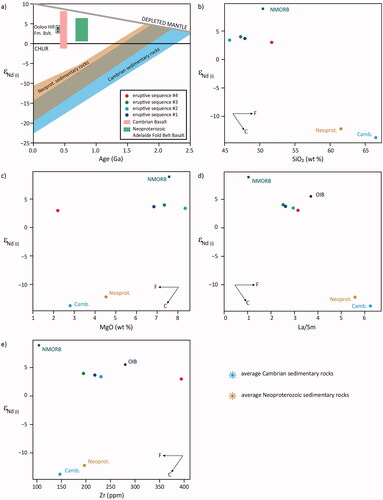
The upper andesite (eruptive sequence #4), however, is tholeiitic and has higher SiO2, and lower MgO, Mg#, Ni and Cr than in the lower basalt sequences but has a similar εNd(390 Ma) to the lower basalt sequences. Higher SiO2, and lower MgO, Mg#, Ni and Cr could result from crustal assimilation or fractional crystallisation. This andesite is also enriched in La, Ce, Zr and Hf relative to the lower eruptive sequences but lacks significant depletions in Nb, Ta and Ti (), as would be expected upon interaction with continental crust. Crustal contamination or assimilation would also result in lower εNd(390 Ma) values; however, εNd is not affected by fractional crystallisation. As the εNd(390 Ma) value is similar to, albeit slightly lower than, the eruptive sequence #1 and #2, the SiO2, MgO, Ni and Cr are markedly different, suggesting fractional crystallisation may be the dominant process in the upper andesite. This is supported by the largely horizontal trends in εNd(390 Ma) against SiO2, MgO, La/Sm and Zr (). The upper andesite displays some evidence of plagioclase fractionation, with negative Sr and subtle negative Eu anomalies (Eu/Eu* = 0.95), and suggests the parent contained modal plagioclase. The upper andesite has no visible olivine and is separated from the lower three flows by ∼30 m of clastic sedimentary rocks that includes several disconformities to unconformities, which may represent a sufficient time interval for differentiation processes to have occurred. The (Gd/Yb)N ratio for the upper andesite is <2 (1.32), consistent with shallow melting (<80 km). Taken together with differences in geochemistry, these features imply that the last eruptive episode may have had a similar but modified magmatic history to the lower sequences, such as may be achieved by a longer crustal residence time to undergo fractional crystallisation. This is also supported by the presence of non-volcanic sediment deposition and erosion between the basalts.
Ooloo Hill Formation basalts and andesite sit above the mid-ocean ridge basalt (MORB)–ocean island basalt (OIB) array and below the metasomatised mantle array on the Th/Yb–Nb/Yb diagram (). Eruptive sequences #1, #2 and #4 form a trend parallel to the MORB–OIB array, consistent with within-plate evolution of mantle sources (e.g. Liu et al., Citation2021), whereas eruptive sequence #3 has an apparent, although tenuous, vertical trend toward the metasomatised mantle array (Elliott et al., Citation1997; Hawkesworth et al., Citation1997). Differing evolutionary trends are also highlighted on , suggesting eruptive sequences #1 and #2 had an asthenospheric mantle source, possibly derived from OIB, and potentially share a common source region to eruptive sequence #4 that underwent differentiation. The separate but parallel offset in eruptive sequence #3 suggests it was derived from a more enriched OIB-like intraplate parent (). The lithospheric component in this eruptive sequence may be linked to slab-melt contributions into the mantle source or lithospheric contamination of a plume-derived source (Xia & Li, Citation2019). The mantle source components for Ooloo Hill Formation were therefore likely to be a heterogeneous OIB-like intraplate parent magma derived from the asthenospheric mantle. Different magma sources for Ooloo Hill Formation are demonstrated by incompatible element ratios () suggesting a dynamic magmatic plumbing system.
Figure 12. Source discrimination diagrams for Ooloo Hill Formation basalts. (a) Th/Yb–Nb/Yb diagram after Pearce (Citation2008). Note the overlap between eruptive sequences #1 and #2 (see inset). (b) Nb/La–La/Yb diagram after Abdel-Rahman (Citation2002). (c) Zr/Y–Zr diagram after Pearce and Norry (Citation1979) showing the within-plate basalt classification for the Ooloo Hill Formation basalts. The trend formed in eruptive sequences #1, #2 and #4 on (a) and (b) raises the possibility that these basalts share a common mantle source, while eruptive sequence #3 sits on a different trend, suggesting a separate mantle source.
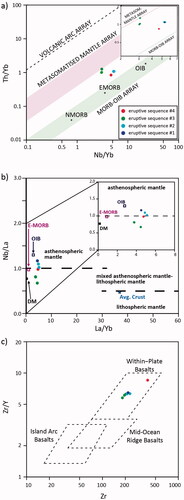
Trace-element systematics (e.g. and ) of Ooloo Hill Formation basalts and andesite suggest two or more relatively small-scale melting events occurred. As discussed above, the basalt from eruptive sequence #3 is of a different composition to the lower two eruptive sequences. Likewise, the youngest andesite represented by the upmost flow (eruptive sequence #4) has a different composition to the older three eruptive sequences. Compositional differences in the uppermost andesite (eruptive sequence #4) may be explained by differentiation processes related to a similar source to eruptive sequences #1 and #2. Eruptive sequence #3, however, appears to represent a different source component unrelated to the source of eruptive sequences #1, #2 and #4. Differences in mantle source components are important, as they may relate to mantle heterogeneities or variability in melt volumes.
Tectonic setting
The small volume and heterogeneous geochemical compositions of the Ooloo Hill Formation volcanic member suggest they formed by batch melting of isolated mantle reservoirs with little crustal residence time. Such melting is of inadequate volume to cause significant melting of the subcontinental lithospheric mantle. As a result, these magmas retain the asthenospheric signature of their source.
Melting may have been driven by decompressional melting in response to lithospheric extension or plate flexure where magmas ascend to the surface along fractures caused by bending of the lithosphere (e.g. Hirano, Citation2011). In the case of the Ooloo Hill Formation, the presence of a relatively restricted, quasi-linear package of basalt and sedimentary rock suggests it may have formed as a result of wrench tectonics, leading to localised downthrown blocks and fault-bend basins (). Pre-existing structural weaknesses related to Neoproterozoic magmatism and rifting may have provided pathways for asthenospheric magma ascent during the Devonian. Upwelling of asthenosphere in such a transtensional environment may have locally mixed enriched lithospheric mantle into the asthenosphere, providing OIB-like intraplate or lithosphere contaminated plume-derived magma sources for Ooloo Hill Formation. This is supported by Zr/Nb and Y/Nb ratios in eruptive sequences #1 and #2 being similar to mantle plume–EMORB ratios (Zr/Nb = 12–12.4 and Y/Nb = 1.9) and eruptive sequences #3 and #4 trend toward higher values (Zr/Nb = 20–20.7, Y/Nb = 3.2–3.5 and Zr/Nb = 17.9 and Y/Nb = 2.1, respectively), consistent with lithospheric contamination (Xia & Li, Citation2019). This is also supported by the within-plate character of Ooloo Hill Formation basalts on the Zr/Y–Zr diagram (), suggesting a setting associated with crustal attenuation and extension (e.g. Liu et al., Citation2021; Xia & Li, Citation2019).
Figure 13. Conceptual diagram of tectonic setting for the Ooloo Hill Formation. (a) Lithospheric scale conceptual diagram showing upwelling of asthenospheric mantle related to pre-existing topography on the lithosphere–asthenosphere boundary, or lithosphere flexure related to far-field stresses, either of which led to localised partial melting. The presence of translithospheric magma ascent pathways may be related to pre-existing weaknesses in the region, with magma being focused towards the mid- to lower-crust before erupting into a fault-bound basin. Diagram not to scale. (b) Detail of eruptive sequences for the Ooloo Hill Formation, emphasising the different magma sources between flows, which have distinct geochemical signatures. Note sedimentation was most widespread between flows #3 and #4, during which time some degree of fractional crystallisation occurred, presumably in a magma chamber setting that influenced the modest enrichment observed in flow #4.
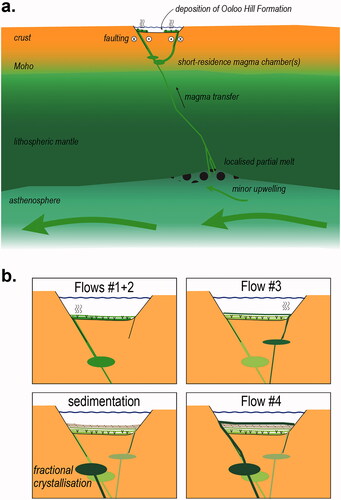
Ooloo Hill Formation overlaps in time with sedimentary units from the Koonenberry Belt to the east deposited in the Bancannia Trough (Mills, Citation2010; see for location), in particular the Wana Karnu Group. The Lower to Middle Devonian Wana Karnu Group comprises mature, clastic sediment and local limestone units, deposited in fluvial to estuarine or marginal marine conditions (Vickery & Gilmore, Citation2010). Notably, the lowermost fluvial units of the Wana Karnu Group were deposited from large fluvial systems that drained from the west (Vickery & Gilmore, Citation2010), which suggests uplifted hinterland to the west, towards the region of the western Delamerian Orogen, onto which the Ooloo Hill Formation was deposited. This is also supported by thermochronological evidence of uplift in the Mt Painter region at ca 400 Ma (McLaren et al., Citation2006). Taken together, the sedimentological and thermochronological data may support a model of lithospheric flexure, with broad amplitude uplift to the west of the Bancannia Tough region (i.e. the region around Ooloo Hill Formation basin).
Figure 14. Sketch map showing major sedimentary and igneous regions of eastern Australia formed during the Early Devonian, modified from Rosenbaum (Citation2018). The Ooloo Hill Formation is shown as an example of a small rift basin developed above pre-existing crust to the northwest of the Coompana Province. The Adavale and Darling basins are indicated, with approximate axis of extension that formed the basin after Rosenbaum (Citation2018). Archean/Proterozoic terranes are undifferentiated.

More broadly across eastern Australia, Ooloo Hill Formation overlaps in age with sedimentation in a series of larger early Devonian intracontinental or rift basins, most notably the Darling and Adavale basins (). These basins formed above Cambrian to Silurian sequences and highly extended Paleo–Mesoproterozoic crust (e.g. Frogtech Geoscience, Citation2018), largely as a series of inter-connected grabens and half grabens that filled with fluvial to marine sedimentary successions (e.g. Alder et al., Citation1998). Each of these basins formed inboard of the paleo-Pacific active continental margin of eastern Australia. The changing dynamics of the accretionary orogen inboard of this subduction system has resulted in a complex geological record of tectonic switching from basin formation to contractional deformation (e.g. Abdullah & Rosenbaum, Citation2018; Collins, Citation2002; Glen, Citation2013; Moresi et al., Citation2014; Rosenbaum, Citation2018). Wrenching of the Australian continent far-inboard of the accretionary zone may have contributed to the formation of basins such as the Darling and Adavale, and, at a smaller scale, of the basin into which Ooloo Hill Formation was deposited. We note that this time period was also a time of significant intracontinental tectonism in central Australia, known as the Alice Springs Orogeny (e.g. Buick et al., Citation2008), indicating the entire continent was undergoing tectonic processes ranging from extension and basin formation to thrusting and uplift. The formation of Ooloo Hill Formation is a small example of how the geodynamics of the over-riding continental lithosphere can influence the behaviour of the asthenospheric mantle through time, and vice versa.
Conclusions
The Ooloo Hill Formation represents the first record of a Devonian intracontinental volcano-sedimentary basin in South Australia. It occurs as a <370 km2 magnetic anomaly beneath Cretaceous and younger sedimentary successions to the northwest of the Flinders Ranges. The Ooloo Hill Formation contains submarine basaltic magmatism and associated clastic sedimentation in two depositional packages, one dominated by clastic sedimentary facies and the other comprising basalt flows with thin clastic sedimentary and polymict conglomerate layers. Whole-rock K–Ar dating of basalts yields an age of ca 390 Ma. Detrital zircon U–Pb ages show provenance is dominantly nearby Neoproterozoic sedimentary rocks and maximum depositional age of ca 527 and 510 Ma, confirming these rocks post-date the Neoproterozoic units of the adjacent, and presumably underlying, Adelaide Superbasin. Basalts in the Ooloo Hill Formation represent at least four eruptive sequences that comprise alkalic basalt in the lower three flows and tholeiitic andesite in the uppermost flow. The basalts have an OIB-like mantle source/origin, most likely derived from 60–80 km depth, that represents at least two small-scale melting events from compositionally variable mantle reservoirs and expressing little interaction with lithospheric/subcontinental lithospheric mantle. The andesite may represent a differentiate of the OIB-like parent magma that formed earlier basaltic eruptive sequences.
The Ooloo Hill Formation is located far-field of an accretionary orogen and could represent a small backarc basin or transpressional/transtensional basin. This restricted basin formed inboard of the accretionary orogen of the Tasmanides and is likely a manifestation of complex Paleozoic intracontinental deformation preserved across much of central Australia.
Appendix 1
Download PDF (223.5 KB)Appendix 2
Download MS Excel (31.4 KB)Appendix 3
Download MS Excel (46.6 KB)Acknowledgements
Horst Zwingmann of Curtin University is thanked for undertaking K–Ar geochronology. Peter Wieland at Macquarie GeoAnalytical is thanked for major- and trace-element analyses. David Bruce, University of Adelaide, is thanked for assistance with Sm–Nd analysis. Lucy McGee, University of Adelaide, is thanked for insightful discussions and reviewing of an earlier version of this manuscript, which greatly improved the ideas presented here. The authors acknowledge helpful reviews and comments from E. Beyer and S. McLaren. Jess Bonsell is thanked for drafting . CW, AR and EJ publish with the permission of the Director of the Geological Survey of South Australia.
Disclosure statement
No potential conflict of interest was reported by the author(s).
References
- Abdel-Rahman, A-F. M. (2002). Mesozoic volcanism in the Middle East: Geochemical, isotopic and petrogenetic evolution of extension-related alkali basalts from central Lebanon. Geological Magazine, 139(6), 621–640. https://doi.org/10.1017/s0016756802006829.
- Abdullah, R., & Rosenbaum, G. (2018). Devonian Crustal Stretching in the Northern Tasmanides (Australia) and implications for Oroclinal Bending. Journal of Geophysical Research: Solid Earth, 123(8), 7108–7125. https://doi.org/10.1029/2018JB015724.
- Alder, J. D., Bembrick, C., Hartung-Kagi, B., Mullard, B., Pratt, D. A., Scott, J., & Shaw, R. D. (1998). A re-assessment of the petroleum potential of the Darling Basin: A discovery 2000 initiative. The APPEA Journal, 38(1), 278–312. https://doi.org/10.1071/AJ97014
- Alley, N. F. (1998). Cainozoic stratigraphy, palaeoenvironments and geological evolution of the Lake Eyre Basin. Palaeogeography, Palaeoclimatology, Palaeoecology, 144(3–4), 239–263. https://doi.org/10.1016/S0031-0182(98)00120-5.
- Armit, R. J., Betts, P. G., Schaefer, B. F., & Ailleres, L. (2012). Mesoproterozoic and Palaeozoic constraints on long-lived poly-deformation in the northern Mount Painter Inlier. Gondwana Research, 22(1), 207–226. https://doi.org/10.1016/j.gr.2011.11.003.
- Armit, R. J., Betts, P. G., Schaefer, B. F., Pankhurst, M. J., & Giles, D. (2014). Provenance of the Early Mesoproterozoic Radium Creek Group in the northern Mount Painter Inlier: Correlating isotopic signatures to inform tectonic reconstructions. Precambrian Research, 243, 63–87. https://doi.org/10.1016/j.precamres.2013.12.022.
- Barlow, M. G., & Waterfield, D. W. (1995). Woodgate Bore. Final and relinquishment report for the period 30/12/93 to 29/12/94. https://sarigbasis.pir.sa.gov.au/WebtopEw/ws/samref/sarig1/image/DDD/ENV08869.pdf
- Bonhomme, M. (1975). Methode de datation potassium–argon: appareillage et technique. Université Louis Pasteur.
- Buick, I. S., Storkey, A., & Williams, I. S. (2008). Timing relationships between pegmatite emplacement, metamorphism and deformation during the intra-plate Alice Springs Orogeny, central Australia. Journal of Metamorphic Geology, 26(9), 915–936. https://doi.org/10.1111/j.1525-1314.2008.00794.x.
- Collins, W. J. (2002). Nature of extensional accretionary orogens. Tectonics, 21(4), 1–6. https://doi.org/10.1029/2000TC001272.
- Eiler, J. M., McInnes, B., Valley, J. W., Graham, C. M., & Stolper, E. M. (1998). Oxygen isotope evidence for slab-derived fluids in the sub-arc mantle. Nature, 393(6687), 777–781. https://doi.org/10.1038/31679
- Elburg, M. A., Bons, P. D., Foden, J., & Brugger, J. (2003). A newly defined Late Ordovician magmatic‐thermal event in the Mt Painter Province, northern Flinders Ranges, South Australia. Australian Journal of Earth Sciences, 50(4), 611–631. https://doi.org/10.1046/j.1440-0952.2003.01016.x
- Elliott, T., Plank, T., Zindler, A., White, W., & Bourdon, B. (1997). Element transport from slab to volcanic front at the Mariana arc. Journal of Geophysical Research, 102(B7), 14991–15019. https://doi.org/10.1029/97JB00788
- Foden, J., E, M. A., Dougherty‐Page, J., & Burtt, A. (2006). The timing and duration of the Delamerian Orogeny: Correlation with the Ross Orogen and implications for Gondwana Assembly. The Journal of Geology, 114(2), 189–210. https://doi.org/10.1086/499570
- Foden, J., Song, S. H., Turner, S., Elburg, M., Smith, P. B., Van der Steldt, B., & Van Penglis, D. (2002). Geochemical evolution of lithospheric mantle beneath S.E. South Australia. Chemical Geology, 182(2–4), 663–695. http://www.sciencedirect.com/science/article/pii/S0009254101003473.
- Foley, S., Tiepolo, M., & Vannucci, R. (2002). Growth of early continental crust controlled by melting of amphibolite in subduction zones. Nature, 417(6891), 837–840. https://doi.org/10.1038/nature00799.
- Geoscience, F. (2018). Adavale Basin SEEBASE© Study and GIS (Queensland Geological Record 2018/004). https://gsq-horizon.s3-ap-southeast-2.amazonaws.com/QDEX/109626/cr_109626_1.pdf.
- Glen, R. A. (2013). Refining accretionary orogen models for the Tasmanides of eastern Australia. Australian Journal of Earth Sciences, 60(3), 315–370. https://doi.org/10.1080/08120099.2013.772537.
- Glorie, S., Agostino, K., Dutch, R., Pawley, M., Hall, J., Danišík, M., Evans, N. J., & Collins, A. S. (2017). Thermal history and differential exhumation across the Eastern Musgrave Province, South Australia: Insights from low-temperature thermochronology. Tectonophysics, 703–704, 23–41. https://doi.org/10.1016/j.tecto.2017.03.003.
- Goldstein, S. L., O’Nions, R. K., & Hamilton, P. J. (1984). A Sm-Nd isotopic study of atmospheric dusts and particulates from major river systems. Earth and Planetary Science Letters, 70(2), 221–236. https://doi.org/10.1016/0012-821X(84)90007-4
- Hand, M., & Buick, I. S. (2001). Tectonic history of the Reynolds-Anmatjira Ranges: A case study of reactivation in central Australia. Geological Society, London, Special Publications, 184(1), 237–260. https://doi.org/10.1144/GSL.SP.2001.184.01.12.
- Hart, S. R., Blusztajn, J., Dick, H. J. B., Meyer, P. S., & Muehlenbachs, K. (1999). The fingerprint of seawater circulation in a 500-meter section of ocean crust gabbros. Geochimica et Cosmochimica Acta, 63(23–24), 4059–4080. https://doi.org/10.1016/S0016-7037(99)00309-9.
- Hawkesworth, C., Turner, S., Peate, D., McDermott, F., & van Calsteren, P. (1997). Elemental U and Th variations in island arc rocks: Implications for U-series isotopes. Chemical Geology, 139(1–4), 207–221. https://doi.org/10.1016/S0009-2541(97)00036-3.
- Hess, J. C., & Lippolt, H. J. (1994). Compilation of K/Ar measurements on HD-B1 standard biotite; 1994 status report. In G. S. Odin (Ed.), Phanerozoic time scale. Bulletin de Liaison et D’information (vol. 12, pp. 19–23). Bulletin de Liaison et d’information, IUGS Subcommission, Geochronology.
- Hirano, N. (2011). Petit-spot volcanism: A new type of volcanic zone discovered near a trench. Geochemical Journal, 45(2), 157–167. https://doi.org/10.2343/geochemj.1.0111.
- Hore, S. B., Hill, S. M., Reid, A., Wade, B., Alley, N. F., & Mason, D. R. (2020). U–Pb geochronology reveals evidence of a Late Devonian hydrothermal event, and protracted hydrothermal–epithermal system, within the Mount Painter Inlier, northern Flinders Ranges, South Australia. Australian Journal of Earth Sciences, 67(7), 1009–1044. https://doi.org/10.1080/08120099.2020.1793383.
- Irvine, T. N., & Baragar, W. R. A. (1971). A guide to the chemical classification of the common volcanic rocks. Canadian Journal of Earth Sciences, 8(5), 523–548. https://doi.org/10.1139/e71-055
- Kamber, B. S., & Collerson, K. D. (2000). Zr/Nb systematics of ocean island basalts reassessed—the case for binary mixing. Journal of Petrology, 41(7), 1007–1021. https://doi.org/10.1093/petrology/41.7.1007
- Klein, E. M. (2004). Geochemistry of the Igneous Oceanic Crust. In H. D. Holland & K. K. Turekian (Eds.), Treatise on geochemistry (Vol. 3, pp. 433–463). Elsevier.
- Liu, H-D., Cheng, Y-H., Santosh, M., Teng, X-M., Zhang, X-W., & Teng, X-J. (2021). Magmatism associated with lithospheric thinning, mantle upwelling, and extensional tectonics: Evidence from Carboniferous–Permian dyke swarms and granitoids from Inner Mongolia, Central Asian Orogenic Belt. Lithos, 386–387, 106004. https://doi.org/10.1016/j.lithos.2021.106004.
- Lloyd, J. C., Blades, M. L., Counts, J. W., Collins, A. S., Amos, K. J., Wade, B. P., Hall, J. W., Hore, S., Ball, A. L., Shahin, S., & Drabsch, M. (2020). Neoproterozoic geochronology and provenance of the Adelaide Superbasin. Precambrian Research, 350, 105849. https://doi.org/10.1016/j.precamres.2020.105849.
- McLaren, S., Dunlap, W. J., Sandiford, M., & McDougall, I. (2002). Thermochronology of high heat-producing crust at Mount Painter, South Australia: Implications for tectonic reactivation of continental interiors. Tectonics, 21(4), 2-1–2-18. https://doi.org/10.1029/2000TC001275
- McLaren, S., Sandiford, M., Powell, R., Neumann, N., & Woodhead, J. (2006). Palaeozoic intraplate crustal anatexis in the Mount Painter Province, South Australia: Timing, thermal budgets and the role of crustal heat production. Journal of Petrology, 47(12), 2281–2302. https://doi.org/10.1093/petrology/egl044.
- Middlemost, E. A. K. (1994). Naming materials in the magma/igneous rock system. Earth-Science Reviews, 37(3–4), 215–224. https://doi.org/10.1016/0012-8252(94)90029-9.
- Mills, K. J. (2010). Explanatory notes for the Koonenberry Belt geological maps (Bulletin 35. pp. 425–441). (Explanatory notes for the Koonenberry Belt geological maps). Geological Survey of New South Wales.
- Minty, B. R. S., & Poudjom Djomani, Y. (2019). Total Magnetic Intensity (TMI) Grid of Australia 2019 – seventh edition—40 m cell size. Geoscience Australia.
- Moresi, L., Betts, P. G., Miller, M. S., & Cayley, R. A. (2014). Dynamics of continental accretion. Nature, 508(7495), 245–248. https://doi.org/10.1038/nature13033
- Nicholson, H., & Latin, D. (1992). Olivine Tholeiites from Krafla, Iceland: Evidence for variations in melt fraction within a plume. Journal of Petrology, 33(5), 1105–1124. https://doi.org/10.1093/petrology/33.5.1105.
- Odin, G, & collaborators. (1982). Interlaboratory standards for dating purposes. In G. Odin (Ed.), Numerical dating in stratigraphy. Part 1 (pp. 123–148). John Wiley and Sons.
- Pearce, J. A. (2008). Geochemical fingerprinting of oceanic basalts with applications to ophiolite classification and the search for Archean oceanic crust. Lithos, 100(1–4), 14–48. https://doi.org/10.1016/j.lithos.2007.06.016.
- Pearce, J. A., Ernst, R. E., Rogers, C., & Peate, D. W. (2017). LIP Printing: A geochemical proxy approach to LIP Forensics. Geological Society of America Annual Meeting.
- Pearce, J. A., & Norry, M. J. (1979). Petrogenetic implications of Ti, Zr, Y, and Nb variations in volcanic rocks. Contributions to Mineralogy and Petrology, 69(1), 33–47. https://doi.org/10.1007/BF00375192.
- Pearce, J. A., & Peate, D. W. (1995). Tectonic implications of the composition of volcanic arc magmas. Annual Review of Earth and Planetary Sciences, 23(1), 251–285. https://doi.org/10.1146/annurev.ea.23.050195.001343.
- Preiss, W. V. (1987). The Adelaide Geosyncline: Late Proterozoic stratigraphy, sedimentation, palaeontology and tectonics (Bulletin 53). Geological Survey of South Australia. https://sarigbasis.pir.sa.gov.au/WebtopEw/ws/samref/sarig1/image/DDD/BULL053.pdf
- Preiss, W. V. (1995). Delamerian Orogeny. In J. F. Drexel, W. V. Preiss, & A. J. Parker, (Eds.), The geology of South Australia; Volume 2, The Phanerozoic (Bulletin 54, pp. 45–59.). Geological Survey of South Australia. https://sarigbasis.pir.sa.gov.au/WebtopEw/ws/samref/sarig1/image/DDD/BULL054(V2).pdf
- Prouteau, G., Scaillet, B., Pichavant, M., & Maury, R. (2001). Evidence for mantle metasomatism by hydrous silicic melts derived from subducted oceanic crust. Nature, 410(6825), 197–200. https://doi.org/10.1038/35065583.
- Raimondo, T., Hand, M., & Collins, W. J. (2014). Compressional intracontinental orogens: Ancient and modern perspectives. Earth-Science Reviews, 130, 128–153. https://doi.org/10.1016/j.earscirev.2013.11.009.
- Raymond, O. L. (2018). Australian Geological Provinces 2018.01 edition (Geoscience Australia, Canberra, Issue). http://pid.geoscience.gov.au/dataset/ga/116823.
- Rosenbaum, G. (2018). The Tasmanides: Phanerozoic Tectonic evolution of Eastern Australia. Annual Review of Earth and Planetary Sciences, 46(1), 291–325. https://doi.org/10.1146/annurev-earth-082517-010146.
- Rudnick, R. L., & Gao, S. (2003). Composition of the continental crust. In H. D. Holland, R. L. Rudnick, & K. K. Turekian (Eds.), The Crust (Treatise on Geochemistry, vol. 3, pp. 1–64). Elsevier/Pergamon.
- Sheard, M. (2009). CALLABONNA, South Australia. Sheet SH/54-06, International Index. 1:250 000 Geological Series – explanatory notes. Geological Survey of South Australia. https://sarigbasis.pir.sa.gov.au/WebtopEw/ws/samref/sarig1/image/DDD/EXPNOTESCALLABONNA.pdf
- Sheard, M. J. (2012). MARREE, South Australia. Sheet SH/54-05, International Index (second edition). 1:250,000 Geological Series – explanatory notes. Geological Survey of South Australia. https://sarigbasis.pir.sa.gov.au/WebtopEw/ws/samref/sarig1/image/DDD/EXPNOTESMARREE.pdf
- Sheard, M. J., & Callen, R. A. (2000). CALLABONNA map sheet. South Australia. Geological Survey. Geological Atlas 1:250 000 Series, sheet SH 54-6. PIRSA Spatial Information. https://sarigbasis.pir.sa.gov.au/WebtopEw/ws/plans/sarig1/image/DDD/200471-010
- Sheard, M. J., Fanning, C. M., & Flint, R. B. (1992). Geochronology and definition of Mesoproterozoic volcanics and granitoids of the Mount Babbage Inlier, northern Flinders Ranges. Geological Survey of South Australia Quarterly Geological Notes. https://sarigbasis.pir.sa.gov.au/WebtopEw/ws/samref/sarig1/image/DDD/QGN123.pdf
- Sircombe, K. N. (2004). AgeDisplay: an EXCEL workbook to evaluate and display univariate geochronological data using binned frequency histograms and probability density distributions. Computers and Geosciences, 30, 21–31. https://doi.org/10.1016/j.cageo.2003.09.006
- Spandler, C., Hammerli, J., & Yaxley, G. M. (2017). An experimental study of trace element distribution during partial melting of mantle heterogeneities. Chemical Geology, 462, 74–87. https://doi.org/10.1016/j.chemgeo.2017.05.002.
- Steiger, R. H., & Jäger, E. (1977). Subcommission of geochronology: Convention on the use of decay constants in geo- and cosmochronology. Earth and Planetary Science Letters, 36(3), 359–362. https://doi.org/10.1016/0012-821X(77)90060-7.
- Stolz, A. J., Jochum, K. P., Spettel, B., & Hofmann, A. W. (1996). Fluid- and melt-related enrichment in the subarc mantle: Evidence from Nb/Ta variations in the island-arc basalts. Geology, 24(7), 587–590. https://doi.org/10.1130/0091-7613(1996)024≤0587:FAMREI≥2.3.CO;2.
- Sun, S. S., & McDonough, W. F. (1989). Chemical and isotopic systematics of oceanic basalts; implications for mantle composition and processes. In A. D. Saunders & M. J. Norry (Eds.), Magmatism in the ocean basins (pp. 313–345). Geological Society Special Publications, Geological Society London.
- Turner, S., Foden, J., Sandiford, M., & Bruce, D. (1993). Sm–Nd isotopic evidence for the provenance of sediments from the Adelaide fold belt and southeastern Australia with implications for episodic crustal addition. Geochimica et Cosmochimica Acta, 57(8), 1837–1856. https://doi.org/10.1016/0016-7037(93)90116-E
- Valentine, G. A., & Hirano, N. (2010). Mechanisms of low-flux intraplate volcanic fields—Basin and Range (North America) and northwest Pacific Ocean. Geology, 38(1), 55–58. https://doi.org/10.1130/g30427.1
- Vermeesch, P. (2004). How many grains are needed for a provenance study? Earth and Planetary Science Letters, 224(3–4), 441–451. https://doi.org/10.1016/j.epsl.2004.05.037.
- Vickery, N. M., & Gilmore, P. J. (2010). Wana Karnu group (Bulletin 35. pp. 193–224). (Explanatory notes for the Koonenberry Belt geological maps). Geological Survey of New South Wales. https://search.geoscience.nsw.gov.au/product/17.
- Wade, B., Barovich, K., Hand, M., Scrimgeour, I. R., & Close, D. F. (2006). Evidence for early Mesoproterozoic arc-related magmatism in the Musgrave Block, central Australia: Implications for Proterozoic crustal growth and tectonic reconstructions of Australia. The Journal of Geology, 114(1), 43–63. https://doi.org/10.1086/498099
- Walker, D. A., & McDougall, I. (1982). 40Ar39Ar and KAr dating of altered glassy volcanic rocks: the Dabi Volcanics, P.N.G. Geochimica et Cosmochimica Acta, 46(11), 2181–2190. https://doi.org/10.1016/0016-7037(82)90193-4
- White, M. R., Sheard, M. J., & Reid, P. W. (2012). MARREE map sheet, second edition. South Australia. Geological Survey. Geological Atlas 1:250,000 Series, sheet SH 54-5. Co-published by PIRSA Spatial Information & DMITRE.
- Xia, L., & Li, X. (2019). Basalt geochemistry as a diagnostic indicator of tectonic setting. Gondwana Research, 65, 43–67. https://doi.org/10.1016/j.gr.2018.08.006
- Zwingmann, H., & Mancktelow, N. (2004). Timing of Alpine fault gouges. Earth and Planetary Science Letters, 223(3–4), 415–425. https://doi.org/10.1016/j.epsl.2004.04.041

